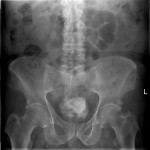Re: Urethral diverticulectomy with Martius fat pad interposition improves symptom resolution and reduces recurrence
Letter to the Editor
Urethral diverticulectomy with Martius fat pad interposition improves symptom resolution and reduces recurrence
Sir,
I read with interest the above paper published online in BJU International,[1] but must take issue with the unjustified ‘tabloid headline’, when a more conventional title describing study design, perhaps “Urethral diverticulectomy with labial fat interposition: a retrospective cohort study”, would be more appropriate.
The term ‘Martius’ graft’ has been used to describe several distinct procedures, the original using bulbocavernosus muscle through a vaginal incision,[2] and most subsequent modifications using subcutaneous fat (+/- muscle +/- skin) dissected from a labial incision.[3, 4] In both their earlier,[5]and current,[1] publications this group describe a ‘Martius labial fat pad’. Without wishing to demean Professor Martius’ contribution, the authors might consider calling their procedure either a ‘labial fat graft’, or a ‘modified Martius’ graft’.
The titular statement that “symptom resolution is improved and recurrences reduced” could surely only be claimed on the basis of comparative data, preferably from a randomised study design. In the methods section the authors describe “analyses using Mann-Whitney U test and Student T-Test” (sic), although no such statistical comparisons are provided in the results.
The authors certainly present enviable outcomes from their procedure, particularly given the case mix described. However, to say that “the majority of patients had complete resolution of their symptoms” when pain, UTIs, poor flow, frequency/urgency, and stress urinary incontinence (SUI) persisted in 16-59% seems to dismiss the range of symptoms attributable to diverticula rather too lightly. Most importantly, the authors find 24% new, and 59% persistent SUI, in common with earlier findings,[6] and confirming the minimal impact of labial fat on sphincter function.
Although no comparison is provided in the present paper, the outcomes in their 2009 publication,[5] where selective grafting was used, are not significantly different from routine grafting in the current report. In the former series, four of the six initial failures were in horseshoe diverticula; if this were included amongst the criteria for grafting then even better results might be anticipated from a selective strategy.
The routine use of grafting might be justified if it were free from risk, but this is clearly not the case. The authors describe seven complications including two labial haematomata, one abscess, one urethrovaginal fistula and one meatal stricture. In my own series I have encountered two women sufficiently concerned about labial deformity to seek plastic surgical revision, and two presenting with symptoms of vaginal mass which was not due to recurrence of diverticulum, nor vaginal prolapse, but to swelling of fat within the graft; all required further surgical intervention.
The most common application for interposition grafts in pelvic reconstructive surgery has been obstetric urogenital fistulae, although there has never been high level evidence to support their use in this or other contexts,[7] and recent years have seen a move away from their routine use.[7, 8] Whilst it does have a place, the associated risks mean it should be done only selectively at the time of urethral diverticulectomy. The authors’ data would suggest that women with complex (including horse shoe) diverticula, although perhaps not those with SUI, are the ones most likely to benefit. This question can however only truly be addressed by randomised comparative trial and the authors are well placed to do this in collaboration with other centres undertaking large numbers of complex cases.
- Malde S, Sihra N, Naaseri S, Spilotros M, Solomon E, Pakzad M, et al. Urethral diverticulectomy with Martius fat pad interposition improves symptom resolution and reduces recurrence. BJU Int. 2016:doi: 10.1111/bju.13579.
- Martius H. Die operative Wiederherstellung der vollkommen fehlenden Harnrohre und des Schiessmuskels derselben. Zentralblatt fur Gynakologie. 1928;52:480.
- Sajjadi SG, Hortváth OP, Kalmár K. Martius flap: historical and anatomical considerations. European Journal of Plastic Surgery. 2012;35:711-6.
- Shaw W. The Martius bulbocavernous interposition operation. British Medical Journal. 1949;2(4639):1261-4.
- Ockrim JL, Allen DJ, Shah PJ, Greenwell TJ. A tertiary experience of urethral diverticulectomy: diagnosis, imaging and surgical outcomes. BJU Int. 2009;103(11):1550-4.
- Reeves FA, Inman RD, Chapple CR. Management of symptomatic urethral diverticula in women: a single-centre experience. Eur Urol. 2014;66(1):164-72.
- de Ridder D, Hilton P, Mourad S, Pickard RS, Rovner ES, Stanford E. Fistulae. In: Abrams P, Cardozo LD, Wein A, editors. Incontinence – ICUD-EAU 5th International Consultation on Incontinence. Geneva, Switzerland: EAU Publications; 2013. p. 1527-79.
- Browning A. Lack of value of the Martius fibrofatty graft in obstetric fistula repair. Int J Gynaecol Obstet. 2006;93(1):33-7.
Yours sincerely,
Paul Hilton
Honorary Senior Lecturer in Urogynaecology, Newcastle University, Newcastle upon Tyne, UK; previously Consultant Gynaecologist and Urogynaecologist, Newcastle upon Tyne Hospitals NHS Foundation Trust, Newcastle upon Tyne, UK
Reply by the authors
We would like to thank Mr Hilton for his commentary regarding the title of our paper (1). We had indeed initially considered submitting this paper to the Daily Mail but felt upon review that our core readership should be surgeons. Luckily the BJU Int editorial board is young enough to appreciate a punchy headline!
We were enlightened by the brief history lesson on the evolution of the Martius fat pad of which we have all taken note. The authors’ current practice as stated in the paper is to use a modified Martius flap NOT graft because it remains attached to its blood supply.
We have compared symptoms before and after urethral diverticulectomy – and we hope this is clear from the text. The reviewers of this paper did not require the details of our statistical analysis as the results as listed in the table below speak for themselves– however we are delighted to have provoked such interest and provide them with the table below. P value is paired T-Test for all symptoms pre and post surgery. Analysis of each symptom individually by Chi-Squared yield P< 0.001 for all symptoms except FU pre and post surgery.
| Number Pre-Op | Number Post-Op | ||||
| Mass | 48 | 0 | P =0.00016062 | ||
| Pain | 43 | 8 | |||
| Dysuria | 40 | 0 | |||
| Dyspaerunia | 37 | 0 | |||
| UTIs | 32 | 5 | |||
| PMD | 29 | 1 | |||
| Poor flow | 19 | 5 | |||
| FU | 19 | 10 | |||
| UD | 16 | 0 | |||
| SUI | 29 | 17 | |||
| new SUI | 0 | 5 |
We feel Mr Hilton’s interpretation of our results is unduly pessimistic. Given the recent definition of the term ‘majority’ in the Brexit vote in the UK -the results detailed reveal an outstanding majority. To continue our tabloid theme even the average Daily Mail reader might conclude that resolution of urethral mass in 100%, dysuria in 100%, dyspareunia in 100%, per urethral discharge in 100%, post-voiding dribble in 96%, UTIs in 84%, pain in 81%, poor flow in 76% and frequency/urgency in 63% fits the definition of ‘majority’.
Pre-existing SUI may be a consequence of the urethral diverticulum or more likely a co-pathology – and as such resolution in 41% is very gratifying as diverticulectomy is not a recognised treatment for stress urinary incontinence. New onset SUI persisting at 12 months was only 12% and not the 24% Mr Hilton quotes – and again given our case mix of 80% complex diverticulum this is very gratifying.
The 2009 paper quoted in the letter was a review of only 30 cases from a composite of primary surgeons c.f. this review of 70 cases from a single surgeon in this series (2). The 2009 paper detailed a group with a very different case mix – with 63.3% (19/30) simple diverticulum c.f. only 20% in the current series. Cure was defined symptomatically only and not by prospective MRI and symptoms. The ‘simpler’ nature of this cohort is reflected in the symptomatic outcomes reported including the lower incidence of de novo incontinence – which we have shown to be 0% following excision of a simple urethral diverticulum, and increases with complexity of diverticulum on MRI (3). The 36.7% (11/30) of patients with complex diverticulum in this series required a total of 17 operations for cure. The failures (6/11 -54.5%) reported in this early series were not in those patients operated by the current series authors and no patient in the current series required reoperation for symptomatic urethral diverticulum (0/70 failures).
We have recently published our extensive experience with the modified Martius labial fat pad flap (mMlfpf) interposition (4). In 159 women having this procedure for a variety of indications – 127 (79%) rated the post operative appearance of their labia as good or excellent and only 1 rated it as unsatisfactory. We have had no requests from any of our patients for referral to plastic surgery. There is no such thing as a free lunch (to continue our tabloid theme) or indeed complication free surgery –however mMlfpf appears to be a low morbidity procedure. These findings are corroborated in the recent publication by Phillipe Zimmern’s group who found similarly excellent outcomes in 97 women at a mean of 85 months FU – with only 9% reporting labial asymmetry (5).
We will continue with the ongoing collection of our short and long-term results and endeavour to keep them in the public arena with future publications. We are most interested to hear of Mr Hilton’s complications and experience, and would encourage him to publish his series of urethral diverticulum outcomes to ensure balance and equipoise in the literature.
We thank Mr Hilton for his opinion with regard to the place of the mMlfpf in reconstructive female surgery. Our opinion (backed by our data) is that the use of the mMlfpf significantly reduces symptomatic (1/70 -1.4%) and asymptomatic (1/70 – 1.4%) recurrence) c.f. the 7/30 (23.3%) symptomatic recurrence in our earlier series, and the 7/30 (23.3%) recurrence rate in the series from Han (6).
This is the largest single surgeon series in the literature. Comparator series with a similar number of complex urethral diverticulum are rare in the literature. The largest single centres series published to date of 2 surgeons experience in 89 diverticulum does not offer a suitable comparator as 72 (80.9%) were simple (7). The only comparable series of note is again from Phillipe Zimmern in which the outcomes of 15 patients with horseshoe diverticulum without routine fat pad interposition are detailed (8). De novo SUI reported in 33% and persistent SUI in 73% – and our de novo SUI rate of 16% and persistent SUI rate of 59% compares favourably and is suggestive of benefit from mMlfpf interposition.
We applaud the suggestion of a randomised control trial, and are more than happy to take part in a national or international study.
Yours sincerely,
Tamsin Greenwell
On behalf of the authors.
References:
- Malde S, Sihra N, Naaseri S, Spilotros M, Solomon E, Pakzad M, et al. Urethral diverticulectomy with Martius fat pad interposition improves symptom resolution and reduces recurrence. BJU Int. 2016:doi: 10.1111/bju.13579.
- Ockrim JL, Allen DJ, Shah PJ, Greenwell TJ. A tertiary experience of urethral diverticulectomy: diagnosis, imaging and surgical outcomes. BJU Int. 2009;103(11):1550-4.
- The Effect of MRI Configuration of Urethral Diverticulum on the Incidence of New Onset Urodynamic Stress Urinary Incontinence Following Excision. S Guillaumier, J Jenks, R Hamid, J Ockrim, J Shah, T Greenwell. J Urol 2013; 189 (4): e758 (1846).
- Malde S, Spilotros M, Wilson A, Pakzad M, Hamid R, Ockrim J, Shah PJ, Greenwell T. The uses and outcomes of the Martius fat pad in female urology. World J Urol. 2016 Jul 7. [Epub ahead of print] PMID: 27388009
- Lee D(1), Dillon BE, Zimmern PE. Long-term morbidity of Martius labial fat pad graft in vaginal reconstruction surgery. Urology 2013; 82(6):1261-6.
- Han DH, Jeong YS, Choo MS, Lee KS. Outcomes of surgery of female urethral diverticula classified using magnetic resonance imaging. Eur Urol. 2007; 51(6):1664-70.
- Reeves FA, Inman RD, Chapple CR. Management of symptomatic urethral diverticula in women: a single-centre experience. Eur Urol. 2014;66(1):164-72.
- Popat S, Zimmern PE. Long-term outcomes after the excision of horseshoe urethral diverticulum. Int Urogynecol J. 2015 Dec 15. [Epub ahead of print]



